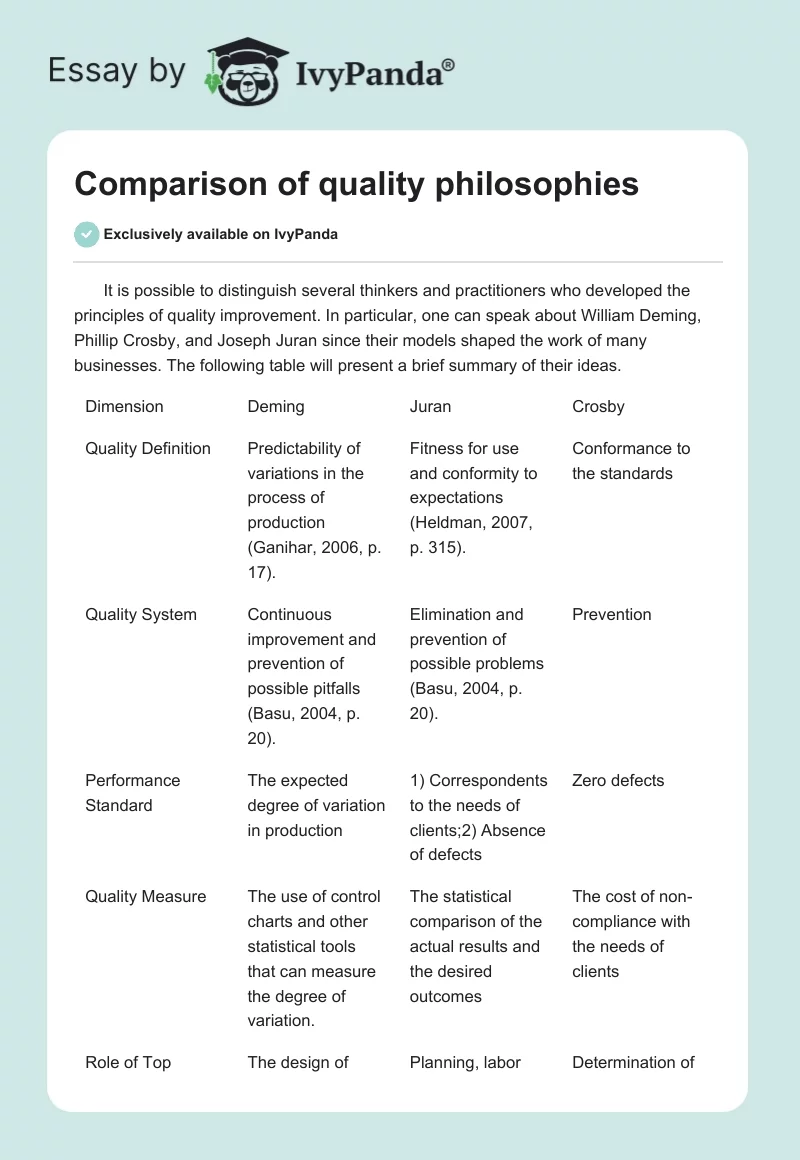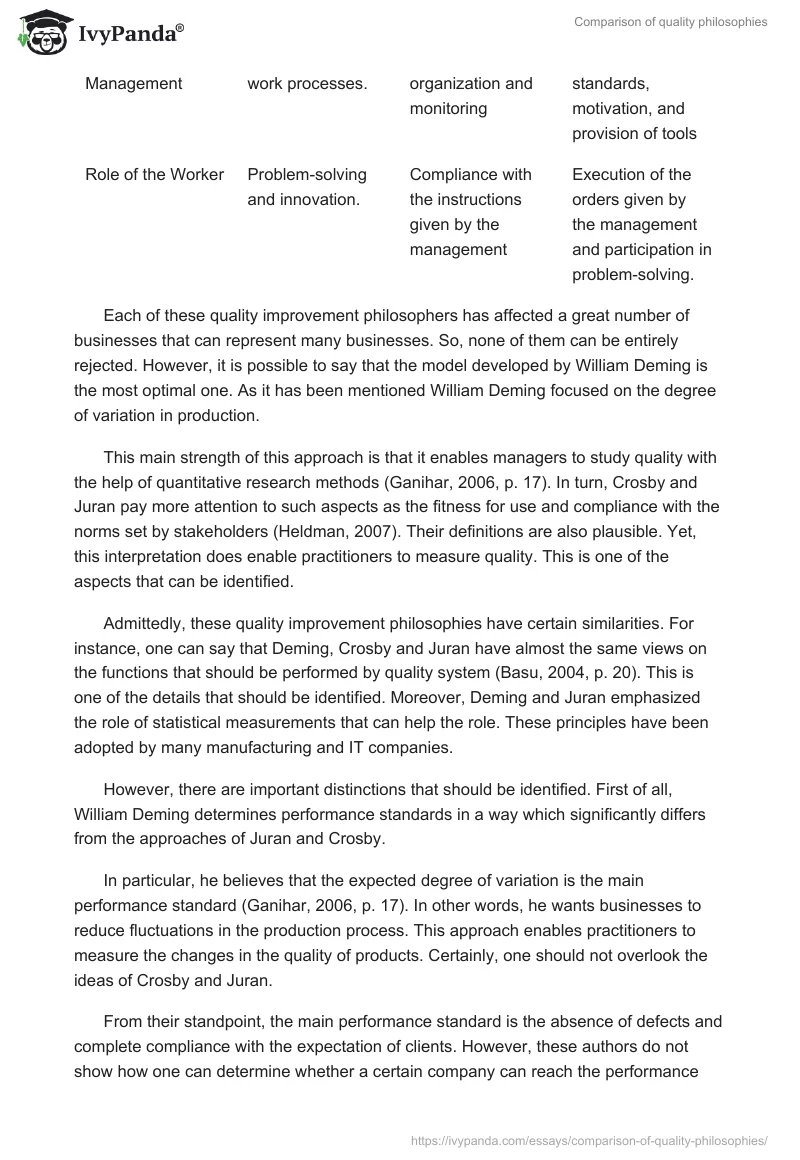It is possible to distinguish several thinkers and practitioners who developed the principles of quality improvement. In particular, one can speak about William Deming, Phillip Crosby, and Joseph Juran since their models shaped the work of many businesses. The following table will present a brief summary of their ideas.
Each of these quality improvement philosophers has affected a great number of businesses that can represent many businesses. So, none of them can be entirely rejected. However, it is possible to say that the model developed by William Deming is the most optimal one. As it has been mentioned William Deming focused on the degree of variation in production.
This main strength of this approach is that it enables managers to study quality with the help of quantitative research methods (Ganihar, 2006, p. 17). In turn, Crosby and Juran pay more attention to such aspects as the fitness for use and compliance with the norms set by stakeholders (Heldman, 2007). Their definitions are also plausible. Yet, this interpretation does enable practitioners to measure quality. This is one of the aspects that can be identified.
Admittedly, these quality improvement philosophies have certain similarities. For instance, one can say that Deming, Crosby and Juran have almost the same views on the functions that should be performed by quality system (Basu, 2004, p. 20). This is one of the details that should be identified. Moreover, Deming and Juran emphasized the role of statistical measurements that can help the role. These principles have been adopted by many manufacturing and IT companies.
However, there are important distinctions that should be identified. First of all, William Deming determines performance standards in a way which significantly differs from the approaches of Juran and Crosby.
In particular, he believes that the expected degree of variation is the main performance standard (Ganihar, 2006, p. 17). In other words, he wants businesses to reduce fluctuations in the production process. This approach enables practitioners to measure the changes in the quality of products. Certainly, one should not overlook the ideas of Crosby and Juran.
From their standpoint, the main performance standard is the absence of defects and complete compliance with the expectation of clients. However, these authors do not show how one can determine whether a certain company can reach the performance standards. More likely, they just set the goals that should be attained, but this objective is not measurable. This is one of the issues that can be singled out.
Yet, the most important aspect is that William Deming pays attention to the design of work processes as one of the main roles that should be played by the top management. He points out that the deficiencies in production can better be explained by the mistakes of the management. In most cases, these problems cannot be attributed to the errors of workers (Ganihar, 2006, p. 17). In contrast, Juran and Crosby pay more attention to planning and monitoring as the main function of senior executives.
The main strength of William Deming’s model is that it urges senior managers to identify the flaws of labor organization. For instance, workers are not likely to ensure the high quality of production, if they do not have the necessary materials or tools. Similar, many problems can occur, provided that managers cannot work out a proper schedule. This issue is often overlooked by business administrators.
Additionally, William Deming attaches much importance to the role that should be played by workers. In particular, he emphasizes the importance of involving these people into problem-solving because they are more familiar with the problems that an organization faces.
In many cases, they can understand the reasons why the products of the company cannot meet the expectations of clients. Moreover, their recommendations can help the management develop better strategies. This approach has been implemented in various Japanese companies such as Toyota (Kaila, 2005, p. 337).
Deming’s ideas have also been of great use to IT companies. In turn, Crosby and Juran believe that employees should only comply with the instructions of the management. They do not emphasize the importance of workers’ initiatives. However, the experience of successful companies shows that the empowerment of employees is critical for the improvement of organizational performance and quality. So, to some degree, William Deming’s philosophy is similar to the principles of the Project Management Institute.
Overall, one can argue that William Deming’s philosophy is premised on such principles as the use of measurable criteria, involvement of employees, and meticulous design of work processes. They can benefit a great number of businesses.
The most important issue is that this approach is now widely applied by many manufacturing and IT enterprises. This is why it has been selected among others. However, one should not dismiss the ideas of Crosby and Juran. For instance, they lay stress on clients’ needs and expectations. This perspective is also of great importance to many businesses.
One should bear in mind that the analysis presented in this paper is based on the perspective of manufacturing organizations. These companies have to deliver certain tangible good to clients. However, one should not forget about the needs of service industry. The organizations representing this sector of economy cannot easily adopt the models described in this paper because Deming, Juran, and Crosby pay more attention to production process (Williams & Buswell, 2003, p. 41).
Certainly, they can use some of the principles described by these scholars, for instance, the idea of involving workers into decision-making and problem-solving. Moreover, these businesses attach importance to the needs of clients. However, in most cases, they should develop different approaches to quality management. These are the main limitations that should be considered.
Reference List
Basu, R. (2004). Implementing Quality: A Practical Guide to Tools and Techniques: Enabling the Power of Operational Excellence. Boston, MA: Cengage Learning EMEA.
Ganihar, N. (2006). Total Quality Culture In Teacher Training Colleges. New York: NY: Discovery Publishing House, 2006.
Heldman, K. (2007). PMP: Project Management Professional Exam Study Guide. New York, NY: John Wiley & Sons.
Kaila, H. (2005). Human Resource Management. New York, NY: Gyan Publishing House.
Williams, C., & Buswell, J. (2003). Service Quality in Leisure and Tourism. Boston, MA: CABI.


